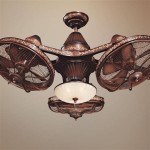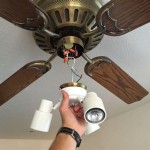Can You Paint Ceiling Fan Blades Black and White?
The allure of a black and white ceiling fan lies in its striking visual impact. While painting your ceiling fan blades can be a fun and cost-effective way to update your decor, certain considerations need to be addressed before embarking on this project. This article will delve into the practical aspects of painting ceiling fan blades black and white, examining the suitability of this color scheme, the necessary steps involved, and potential challenges to be aware of.
Is Painting Ceiling Fan Blades Black and White a Good Idea?
The suitability of painting your ceiling fan blades black and white hinges on the overall design aesthetic of the room. Black and white is a classic combination that can easily blend into various styles, ranging from contemporary to traditional. However, it's crucial to assess how this color scheme will interact with the existing elements of your room. If your walls are already adorned with bold colors or patterns, the black and white fan may not be the ideal choice, as it could create an overly busy look. Conversely, if the room features neutral colors and minimal decor, a black and white ceiling fan can be a striking and elegant focal point.
Beyond aesthetics, practical considerations also play a role. Black surfaces tend to absorb heat, which can be a concern if your fan is located in a room that receives ample sunlight. This added heat can impact the fan's efficiency and potentially lead to increased energy consumption. However, if your fan is primarily used for airflow rather than cooling, the heat absorption effect might not be a significant issue.
Painting Ceiling Fan Blades: Necessary Steps
If you decide to proceed with painting your ceiling fan blades black and white, follow these steps to ensure a successful and durable outcome:
1. Preparation Is Key
Before you start applying paint, it's essential to prepare the surface of the fan blades thoroughly. This involves:
-
Disassembling the Fan:
Carefully detach the fan blades from the motor housing, following the manufacturer's instructions. -
Cleaning the Blades:
Use a mild detergent and warm water to remove any dust, dirt, or grease from the blades. Ensure they are completely dry before proceeding. -
Sanding the Blades:
Lightly sand the blades with fine-grit sandpaper to create a smooth surface for the paint to adhere to. This step is especially important if the blades have been previously painted or have any imperfections. -
Masking:
Use painter's tape to mask off areas you don't want to paint, such as the bolts or any intricate details on the blades.
2. Choosing the Right Paint
Selecting the right paint is crucial for a long-lasting finish. Consider the following factors:
-
Type of Paint:
Opt for an enamel paint specifically designed for metal surfaces. It provides a durable finish that can withstand the wear and tear of a continuously moving fan. -
Finish:
Choose a satin or semi-gloss finish for a smooth, easy-to-clean surface. Avoid flat finishes, as they can attract dust and dirt more easily. -
Primer:
Use a primer compatible with your chosen paint to ensure optimal adhesion and prevent the paint from chipping or peeling.
3. Painting the Blades
Once the blades are prepped and the paint is ready, you can begin the painting process:
-
Applying the Primer:
Apply a thin, even coat of primer to all sides of the fan blades, ensuring complete coverage. Allow the primer to dry completely before proceeding. -
Painting with Black and White:
Apply two thin coats of black paint to one side of each blade and two thin coats of white paint to the other side. Allow each coat to dry fully before applying the next. -
Cleaning the Blades:
Once the paint has dried completely, use a clean, dry cloth to wipe away any paint spills or drips.
4. Reassembling the Fan
Once the paint is completely dry, you can reassemble the fan, following the manufacturer's instructions.
Potential Challenges
While painting ceiling fan blades can be a relatively straightforward project, there are potential challenges to be aware of:
-
Access:
Depending on the height of your ceiling and the design of your fan, accessing the blades for painting might require a ladder or scaffolding, adding an extra layer of complexity to the project. -
Uneven Finish:
If you're not careful, the paint might not be evenly distributed, leading to an uneven finish. You might need to apply multiple thin coats to achieve a smooth, consistent look. -
Chipping and Peeling:
If the blades are not adequately prepared or the paint is not applied correctly, the paint might chip or peel over time.
If you are not comfortable tackling this project yourself, consider hiring a professional painter who has experience painting ceiling fans. They can ensure the proper preparation, painting techniques, and a high-quality finish.

Update A Ceiling Fan Using Spray Paint

Updating An Old Ceiling Fan 100 Things 2 Do

Can Ceiling Fan Blades Be Stained Or Painted Life Should Cost Less

Gonna Do This In Meghans New Bedroom Painting Ceiling Fans Painted Fan Blades

Pin By Kelly Bowen On Diy Projects I Ve Tried Painting Ceiling Fans Fan Redo

How To Paint Fan Blades Like A Pro Tour Of Our Diy House S Light Fixtures The Mommy

Striped Ceiling Fan Blades Project Page

Another Ceiling Fan Makeover And How Not To Paint A Bedroom Painting Fans

Ceiling Fan Makeover 100 Room Challenge The Palette Muse

My Take On Modge Podge Ceiling Fan Redo Thank You For The Idea I Like To Layer Scrapbook Pa Makeover Painting Fans
Related Posts








